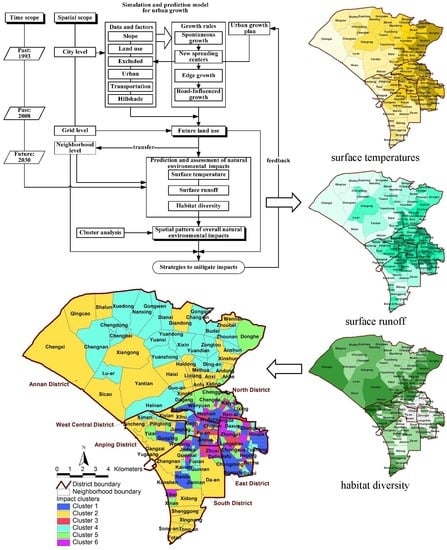Modeling and Simulation of the Future Impacts of Urban Land Use Change on the Natural Environment by SLEUTH and Cluster Analysis
Abstract
:1. Introduction
2. Environmental Impacts of Urban Growth
2.1. Surface Temperature
2.2. Surface Runoff
2.3. Habitat Diversity
3. Materials and Methods
3.1. Study Area
3.2. Framework for Simulating Land Use Changes and Environmental Impact Patterns
3.2.1. A Simulation and Prediction Model for Urban Growth
3.2.2. Prediction and Assessment of Natural Environmental Impact
Surface Temperature
Surface Runoff
Habitat Diversity
3.2.3. Cluster Analysis of Spatial Patterns of Overall Natural Environmental Impact
3.3. Data for Simulation, Prediction and Assessment
4. Results and Discussion
4.1. Simulation and Prediction Land Use Change of Urban Growth
4.2. Analysis of the Simulation of Impact on the Natural Environment
4.2.1. Surface Temperature
4.2.2. Surface Runoff
4.2.3. Habitat Diversity
4.3. Spatial Cluster Analysis of the Impact on the Overall Natural Environment
4.3.1. Cluster 1: Low-Impact Areas
4.3.2. Cluster 2: Positive-Impact Areas
4.3.3. Cluster 3: Moderate- and High-Impact Areas
4.3.4. Cluster 4: Moderate-Impact Areas
4.3.5. Cluster 5: Moderate- and Low-Impact Areas
4.3.6. Cluster 6: High-Impact Areas
4.4. Sustainable Urbanization Strategies
5. Conclusions
Acknowledgments
Author Contributions
Conflicts of Interest
References
- United Nations. World Population Prospects: The 2017 Revision; United Nations: New York, NY, USA, 2017. [Google Scholar]
- Haase, D.; Nuissl, H. Does urban sprawl drive changes in the water balance and policy? The case of Leipzig (Germany) 1870–2003. Landsc. Urban Plan. 2007, 80, 1–13. [Google Scholar] [CrossRef]
- He, C.Y.; Okada, N.; Zhang, Q.F.; Shi, P.J.; Li, J.G. Modelling dynamic urban expansion processes incorporating a potential model with cellular automata. Landsc. Urban Plan. 2008, 86, 79–91. [Google Scholar] [CrossRef]
- Pauleit, S.; Duhme, F. Assessing the environmental performance of land cover types for urban planning. Landsc. Urban Plan. 2000, 52, 1–20. [Google Scholar] [CrossRef]
- Zhao, C.J.; Fu, G.B.; Liu, X.M.; Fu, F. Urban planning indicators, morphology and climate indicators: A case study for a north-south transect of Beijing, China. Build. Environ. 2011, 46, 1174–1183. [Google Scholar] [CrossRef]
- Hasse, J.E.; Lathrop, R.G. Land resource impact indicators of urban sprawl. Appl. Geogr. 2003, 23, 159–175. [Google Scholar] [CrossRef]
- Lambin, E.F.; Meyfroidt, P. Land use transitions: Socio-ecological feedback versus socio-economic change. Land Use Policy 2010, 27, 108–118. [Google Scholar] [CrossRef]
- Zofio, J.L.; Prieto, A.M. Environmental efficiency and regulatory standards: The case of CO2 emissions from OECD industries. Resour. Energy Econ. 2001, 23, 63–83. [Google Scholar] [CrossRef]
- Kattwinkel, M.; Biedermann, R.; Kleyer, M. Temporary conservation for urban biodiversity. Biol. Conserv. 2011, 144, 2335–2343. [Google Scholar] [CrossRef]
- Kohsaka, R. Developing biodiversity indicators for cities: Applying the DPSIR model to Nagoya and integrating social and ecological aspects. Ecol. Res. 2010, 25, 925–936. [Google Scholar] [CrossRef]
- Fox, D.M.; Witz, E.; Blanc, V.; Soulié, C.; Penalver-Navarro, M.; Dervieux, A. A case study of land cover change (1950–2003) and runoff in a Mediterranean catchment. Appl. Geogr. 2012, 32, 810–821. [Google Scholar] [CrossRef]
- Tang, J.; Wang, L.; Yao, Z. Analyses of urban landscape dynamics using multi-temporal satellite images: A comparison of two petroleum-oriented cities. Landsc. Urban Plan. 2008, 87, 269–278. [Google Scholar] [CrossRef]
- Whitford, V.; Ennos, A.R.; Handley, J.F. “City form and natural process”—Indicators for the ecological performance of urban areas and their application to Merseyside, UK. Landsc. Urban Plan. 2001, 57, 91–103. [Google Scholar] [CrossRef]
- Zhang, B.A.; Xie, G.D.; Zhang, C.Q.; Zhang, J. The economic benefits of rainwater-runoff reduction by urban green spaces: A case study in Beijing, China. J. Environ. Manag. 2012, 100, 65–71. [Google Scholar] [CrossRef] [PubMed]
- Hoppe, P. Different aspects of assessing indoor and outdoor thermal comfort. Energy Build. 2002, 34, 661–665. [Google Scholar] [CrossRef]
- Pauleit, S.; Ennos, R.; Golding, Y. Modeling the environmental impacts of urban land use and land cover change—A study in Merseyside, UK. Landsc. Urban Plan. 2005, 71, 295–310. [Google Scholar] [CrossRef]
- Svensson, M.K.; Eliasson, I. Diurnal air temperatures in built-up areas in relation to urban planning. Landsc. Urban Plan. 2002, 61, 37–54. [Google Scholar] [CrossRef]
- Zeller, V.; Bahn, M.; Aichner, M.; Tappeiner, U. Impact of land-use change on nitrogen mineralization in subalpine grasslands in the Southern Alps. Biol. Fertil. Soils 2000, 31, 441–448. [Google Scholar] [CrossRef]
- Christidis, N.; Stott, P.A.; Hegerl, G.C.; Betts, R.A. The role of land use change in the recent warming of daily extreme temperatures. Geophys. Res. Lett. 2013, 40, 589–594. [Google Scholar] [CrossRef] [Green Version]
- Guneralp, B.; Seto, K.C. Futures of global urban expansion: Uncertainties and implications for biodiversity conservation. Environ. Res. Lett. 2013, 8, 1–10. [Google Scholar] [CrossRef]
- Kumar, D.S.; Arya, D.S.; Vojinovic, Z. Modeling of urban growth dynamics and its impact on surface runoff characteristics. Comput. Environ. Urban Syst. 2013, 41, 124–135. [Google Scholar] [CrossRef]
- Barredo, J.I.; Kasanko, M.; McCormick, N.; Lavalle, C. Modelling dynamic spatial processes: Simulation of urban future scenarios through cellular automata. Landsc. Urban Plan. 2003, 64, 145–160. [Google Scholar] [CrossRef]
- Cheng, J.Q.; Masser, I. Understanding spatial and temporal processes of urban growth: Cellular automata modelling. Environ. Plan. B Plan. Des. 2004, 31, 167–194. [Google Scholar] [CrossRef]
- Al-shalabi, M.; Billa, L.; Pradhan, B.; Mansor, S.; Al-Sharif, A.A.A. Modelling urban growth evolution and land-use changes using GIS based cellular automata and SLEUTH models: The case of Sana’a metropolitan city, Yemen. Environ. Earth Sci. 2013, 70, 425–437. [Google Scholar] [CrossRef] [Green Version]
- Mao, X.Y.; Meng, J.J.; Xiang, Y.Y. Cellular automata-based model for developing land use ecological security patterns in semi-arid areas: A case study of Ordos, Inner Mongolia, China. Environ. Earth Sci. 2013, 70, 269–279. [Google Scholar] [CrossRef]
- Sakieh, Y.; Amiri, B.J.; Danekar, A.; Feghhi, J.; Dezhkam, S. Simulating urban expansion and scenario prediction using a cellular automata urban growth model, SLEUTH, through a case study of Karaj City, Iran. J. Hous. Built Environ. 2015, 30, 591–611. [Google Scholar] [CrossRef]
- Badwi, I.M.; El-Barmelgy, M.M.; Ouf, A.S.E.-D. Modeling and Simulation of Greater Cairo Region Urban Dynamics Using SLEUTH. J. Urban Plan. Dev. 2015, 141, 1–19. [Google Scholar] [CrossRef]
- Baynes, T.M. Complexity in Urban Development and Management. J. Ind. Ecol. 2009, 13, 214–227. [Google Scholar] [CrossRef]
- Hua, L.Z.; Tang, L.N.; Cui, S.H.; Yin, K. Simulating Urban Growth Using the SLEUTH Model in a Coastal Peri-Urban District in China. Sustainability 2014, 6, 3899–3914. [Google Scholar] [CrossRef]
- Jantz, C.A.; Goetz, S.J.; Donato, D.; Claggett, P. Designing and implementing a regional urban modeling system using the SLEUTH cellular urban model. Comput. Environ. Urban Syst. 2010, 34, 1–16. [Google Scholar] [CrossRef]
- Kuo, H.F.; Tsou, K.W. Application of Environmental Change Efficiency to the Sustainability of Urban Development at the Neighborhood Level. Sustainability 2015, 7, 10479–10498. [Google Scholar] [CrossRef]
- Sandstrom, U.G.; Angelstam, P.; Khakee, A. Urban comprehensive planning—Identifying barriers for the maintenance of functional habitat networks. Landsc. Urban Plan. 2006, 75, 43–57. [Google Scholar] [CrossRef]
- Wagendorp, T.; Gulinck, H.; Coppin, P.; Muys, B. Land use impact evaluation in life cycle assessment based on ecosystem thermodynamics. Energy 2006, 31, 112–125. [Google Scholar] [CrossRef]
- Ding, H.Y.; Shi, W.Z. Land-use/land-cover change and its influence on surface temperature: A case study in Beijing City. Int. J. Remote Sens. 2013, 34, 5503–5517. [Google Scholar] [CrossRef]
- Leao, S.; Bishop, I.; Evans, D. Spatial-temporal model for demand and allocation of waste landfills in growing urban regions. Comput. Environ. Urban Syst. 2004, 28, 353–385. [Google Scholar] [CrossRef]
- Han, H.; Hwang, Y.; Ha, S.R.; Kim, B.S. Modeling Future Land Use Scenarios in South Korea: Applying the IPCC Special Report on Emissions Scenarios and the SLEUTH Model on a Local Scale. Environ. Manag. 2015, 55, 1064–1079. [Google Scholar] [CrossRef] [PubMed]
- Bihamta, N.; Soffianian, A.; Fakheran, S.; Gholamalifard, M. Using the SLEUTH Urban Growth Model to Simulate Future Urban Expansion of the Isfahan Metropolitan Area, Iran. J. Indian Soc. Remote Sens. 2015, 43, 407–414. [Google Scholar] [CrossRef]
- Rienow, A.; Goetzke, R. Supporting SLEUTH—Enhancing a cellular automaton with support vector machines for urban growth modeling. Comput. Environ. Urban Syst. 2014, 49, 66–81. [Google Scholar] [CrossRef]
- Dietzel, C.; Clarke, K.C. Toward Optimal Calibration of the SLEUTH Land Use Change Model. Trans. GIS 2007, 11, 29–45. [Google Scholar] [CrossRef]
- Jantz, C.A.; Goetz, S.J.; Shelley, M.K. Using the SLEUTH urban growth model to simulate the impacts of future policy scenarios on urban land use in the Baltimore-Washington metropolitan area. Environ. Plan. B Plan. Des. 2004, 31, 251–271. [Google Scholar] [CrossRef]
- Lee, D.R.; Sallee, G.T. A Method of Measuring Shape. Geogr. Rev. 1970, 60, 555–563. [Google Scholar] [CrossRef]
- Silva, E.A.; Clarke, K.C. Complexity, emergence and cellular urban models: Lessons learned from applying sleuth to two Portuguese metropolitan areas. Eur. Plan. Stud. 2005, 13, 93–116. [Google Scholar] [CrossRef]
- Shi, Y.S.; Wu, J.; Shi, S.Z. Study of the Simulated Expansion Boundary of Construction Land in Shanghai Based on a SLEUTH Model. Sustainability 2017, 9, 15. [Google Scholar] [CrossRef]
- Osman, T.; Divigalpitiya, P.; Arima, T. Using the SLEUTH urban growth model to simulate the impacts of future policy scenarios on land use in the Giza Governorate, Greater Cairo Metropolitan region. Int. J. Urban Sci. 2016, 20, 407–426. [Google Scholar] [CrossRef]
- Sakieh, Y.; Amiri, B.; Danekar, A.; Feghhi, J.; Dezhkam, S. Scenario-based evaluation of urban development sustainability: An integrative modeling approach to compromise between urbanization suitability index and landscape pattern. Environ. Dev. Sustain. 2015, 17, 1343–1365. [Google Scholar] [CrossRef]
- Lin, H.T.; Sun, C.Y.; Kuo, H.C.; Lee, K.P. A study of urban populations and the urban heat island intensity in Tainan. City Plan. 2005, 32, 83–97. [Google Scholar]
- Lin, F.R.; Wu, N.J.; Tsay, T.K. Applications of Cluster Analysis and Pattern Recognition for Typhoon Hourly Rainfall Forecast. Adv. Meteorol. 2017, 2017, 1–17. [Google Scholar] [CrossRef]
- Javadi, S.; Hashemy, S.M.; Moha mmadi, K.; Howard, K.W.F.; Neshat, A. Classification of aquifer vulnerability using K-means cluster analysis. J. Hydrol. 2017, 549, 27–37. [Google Scholar] [CrossRef]
- Akin, D.; Dokmeci, V. Cluster Analysis of Interregional Migration in Turkey. J. Urban Plan. Dev. 2015, 141, 1–13. [Google Scholar] [CrossRef]
- Jain, A.K. Data clustering: 50 years beyond K-means. Pattern Recognit. Lett. 2010, 31, 651–666. [Google Scholar] [CrossRef]
- Li, Y.-S.; Chuang, Y.-C. Neighborhood Effects on an Individual’s Health Using Neighborhood Measurements Developed by Factor Analysis and Cluster Analysis. J. Urban Health Bull. N. Y. Acad. Med. 2009, 86, 5–18. [Google Scholar] [CrossRef] [PubMed]
- Scherer, M.; Weidmann, U. Differences in Travel Behavior and Demand Potential of Tram- and Bus-Based Neighborhoods Evidence from a Cluster Analysis. Transp. Res. Rec. 2011, 2217, 1–10. [Google Scholar] [CrossRef]

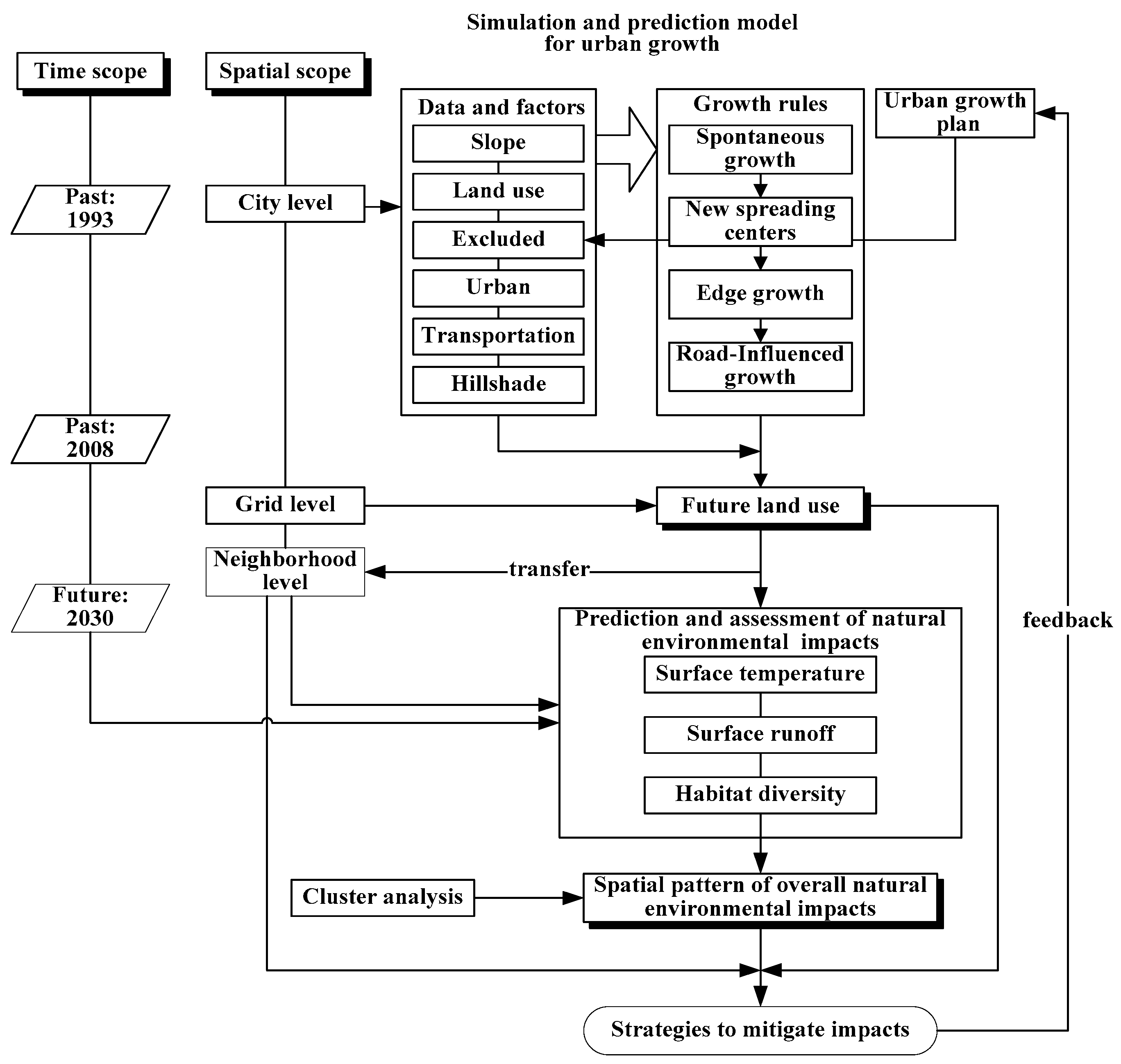
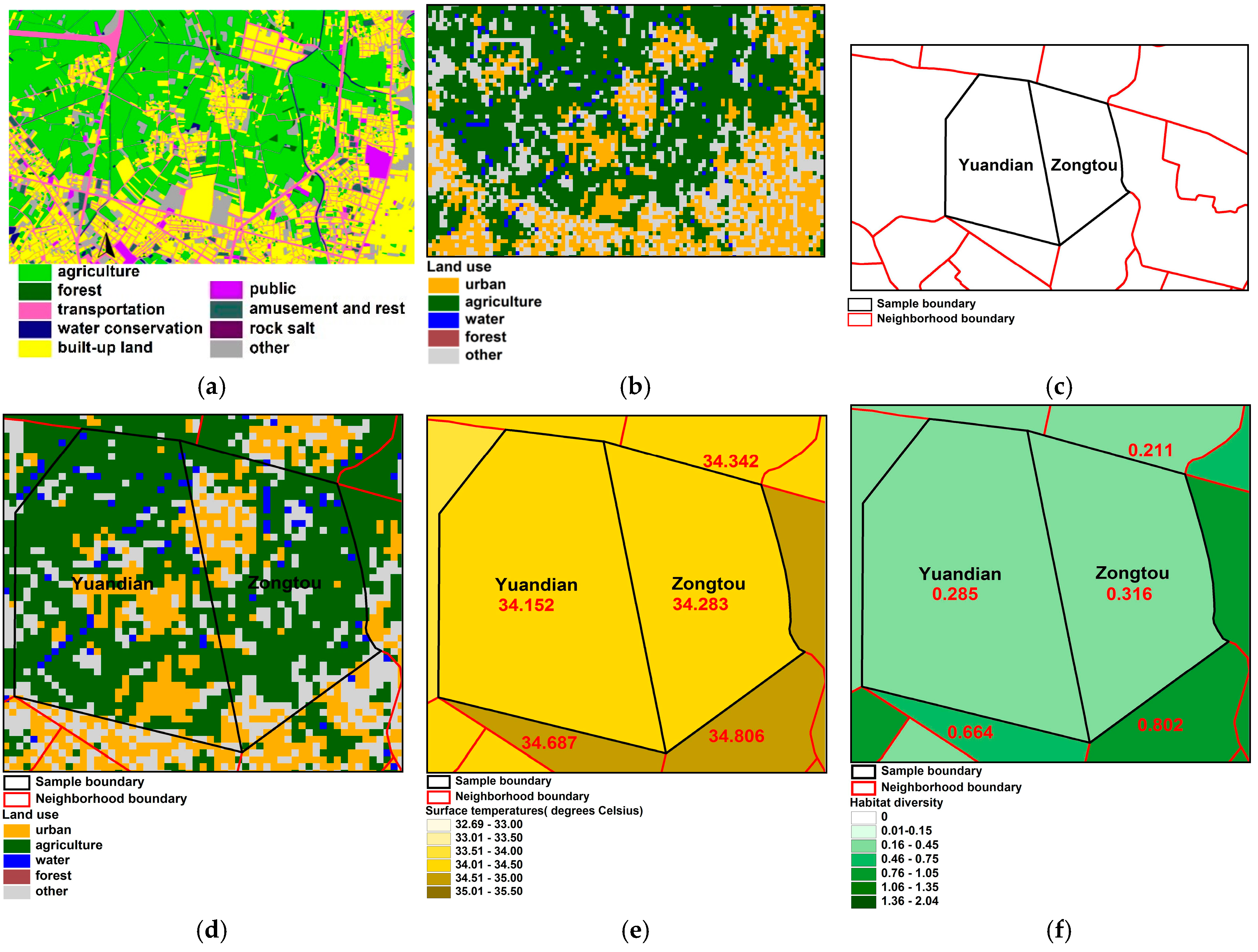

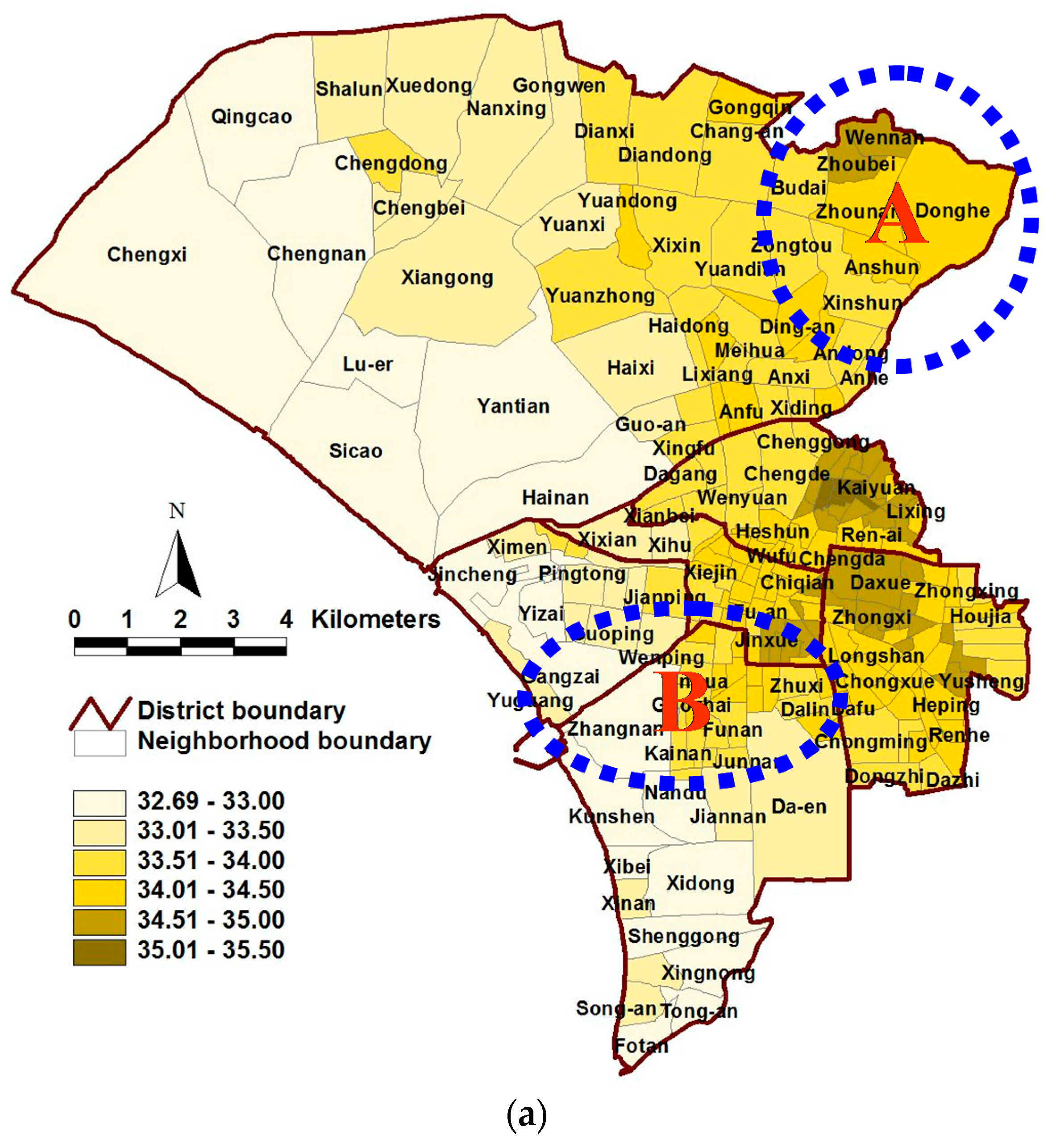
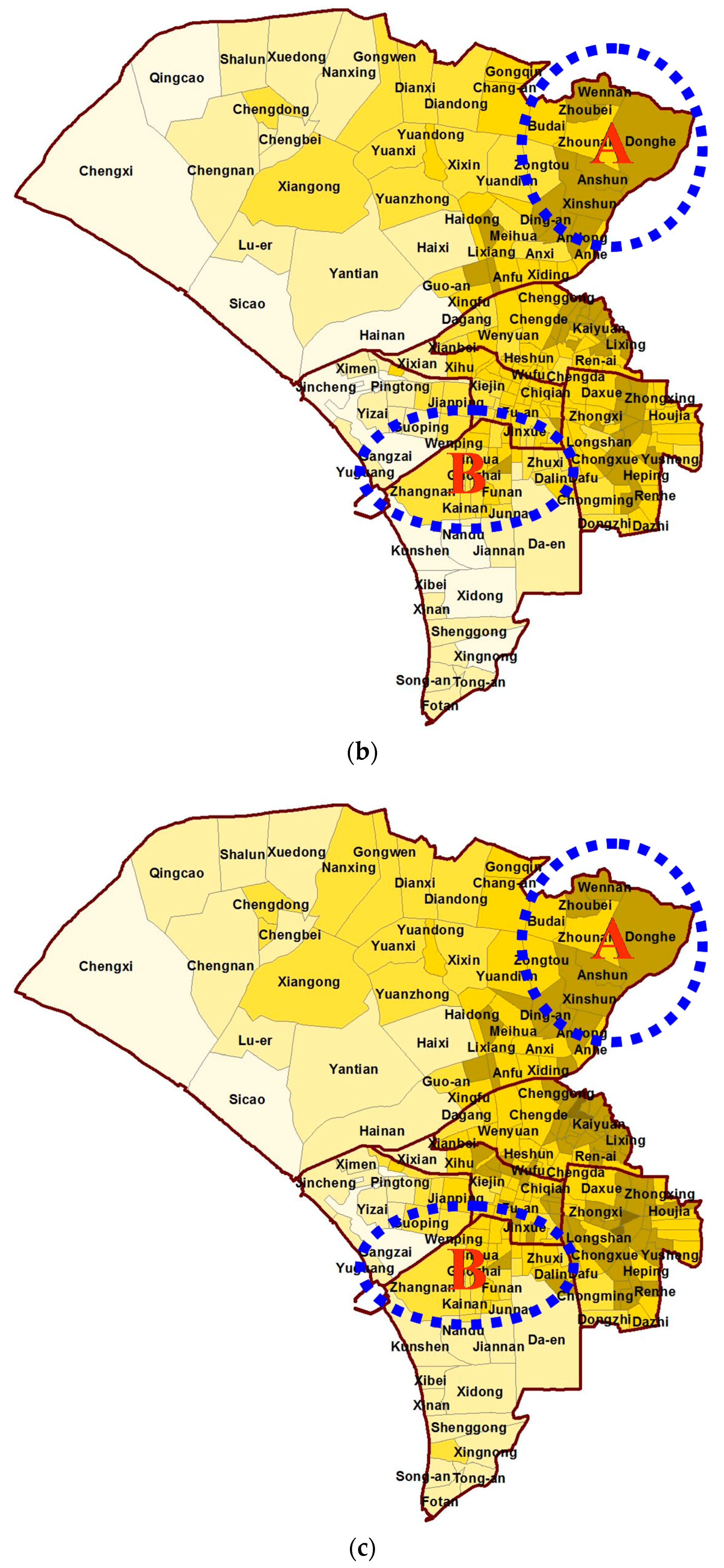
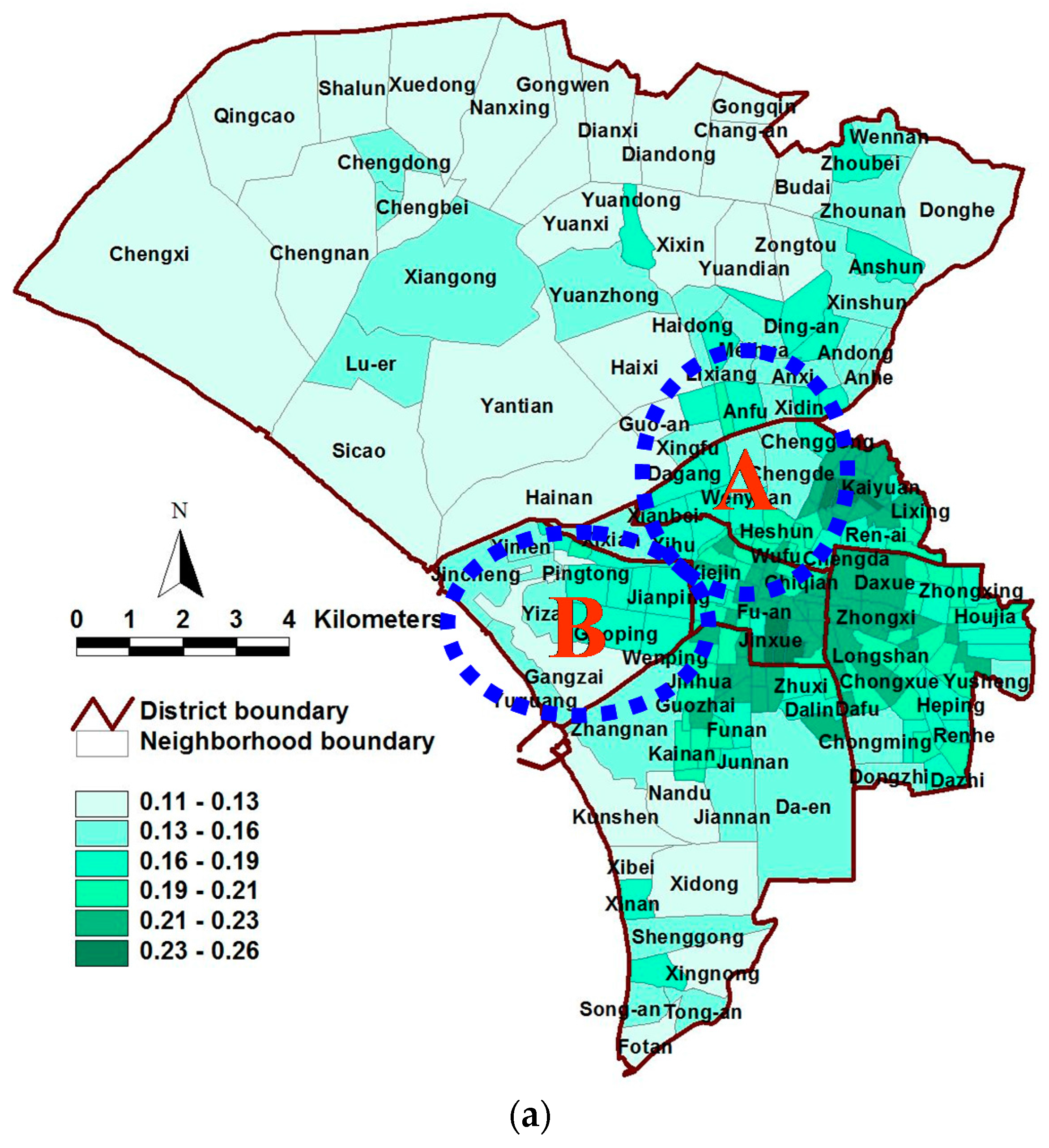
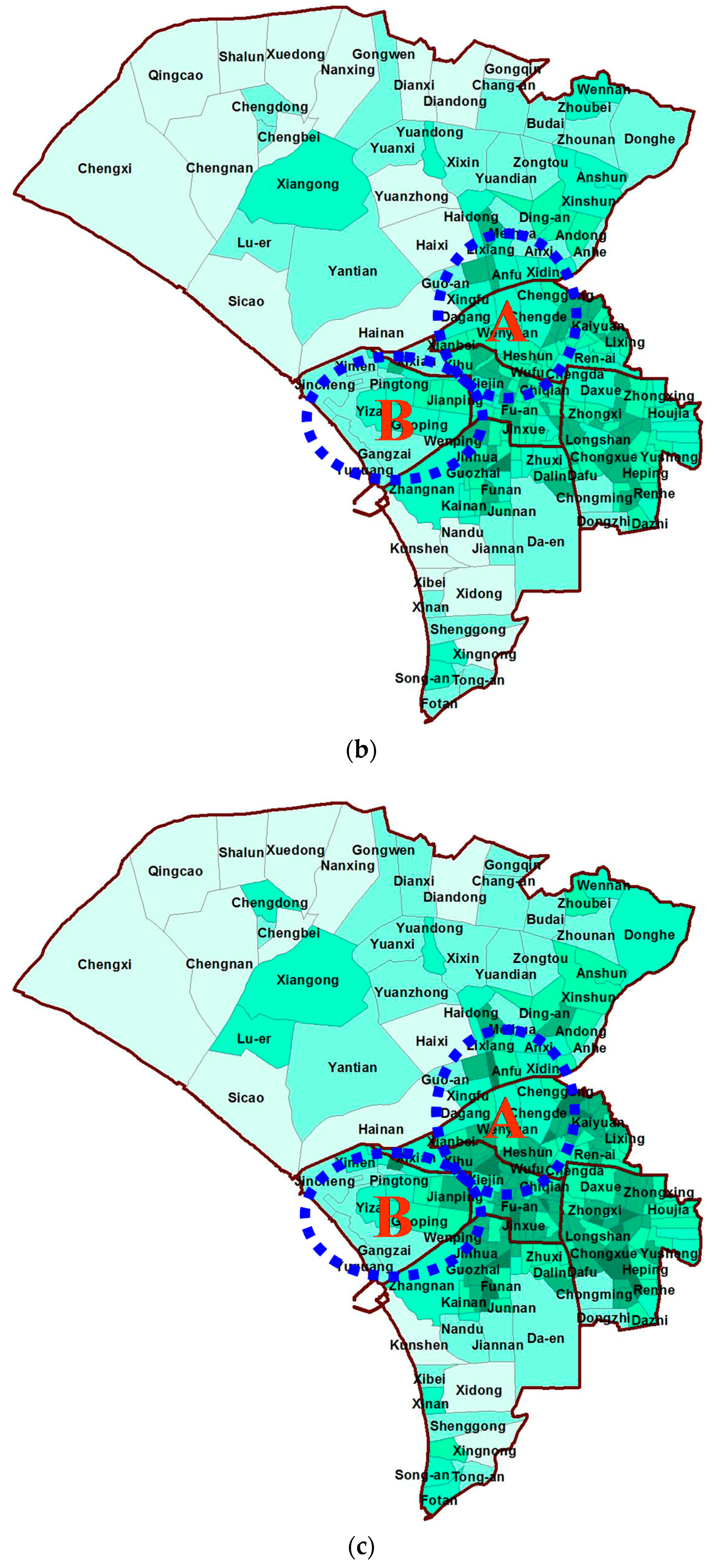
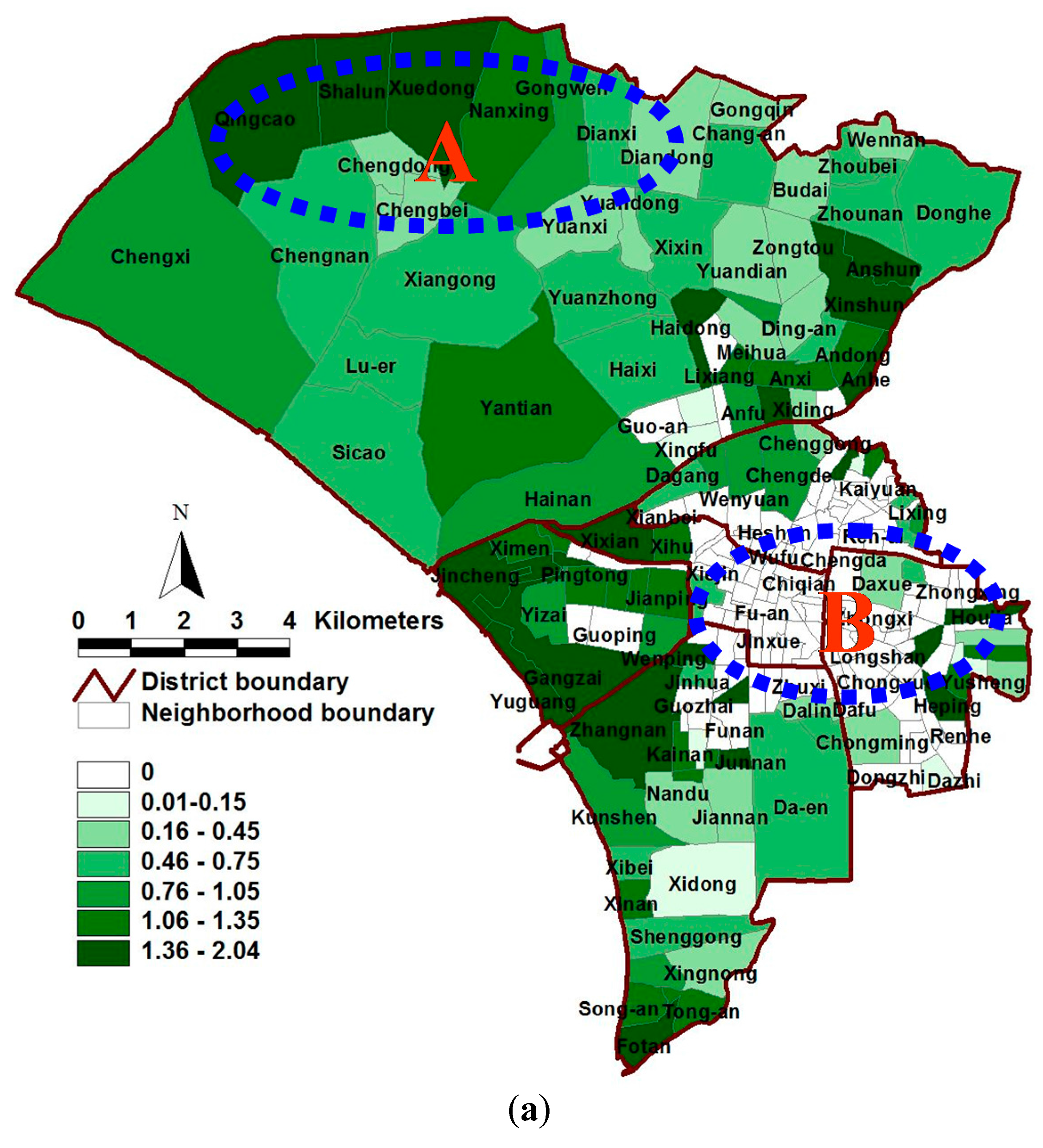
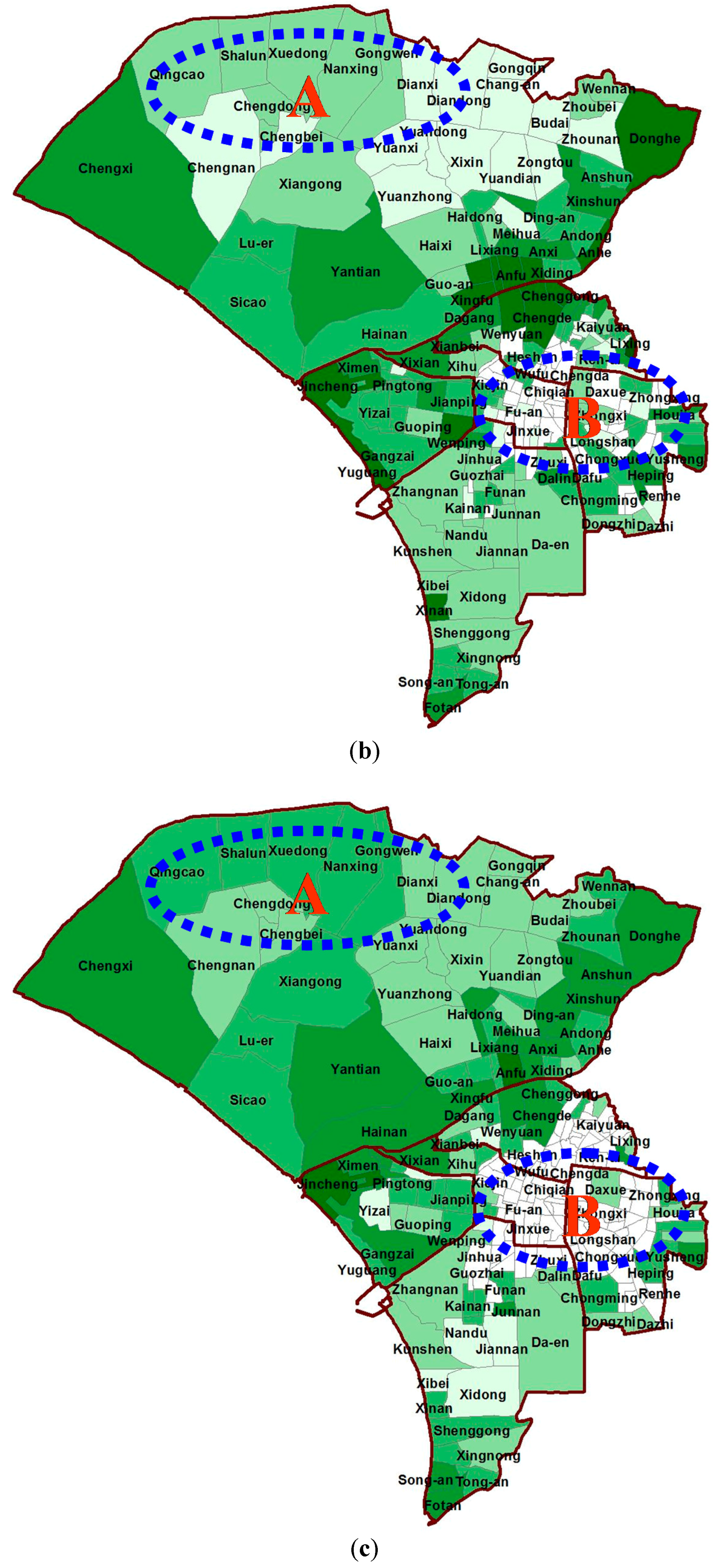
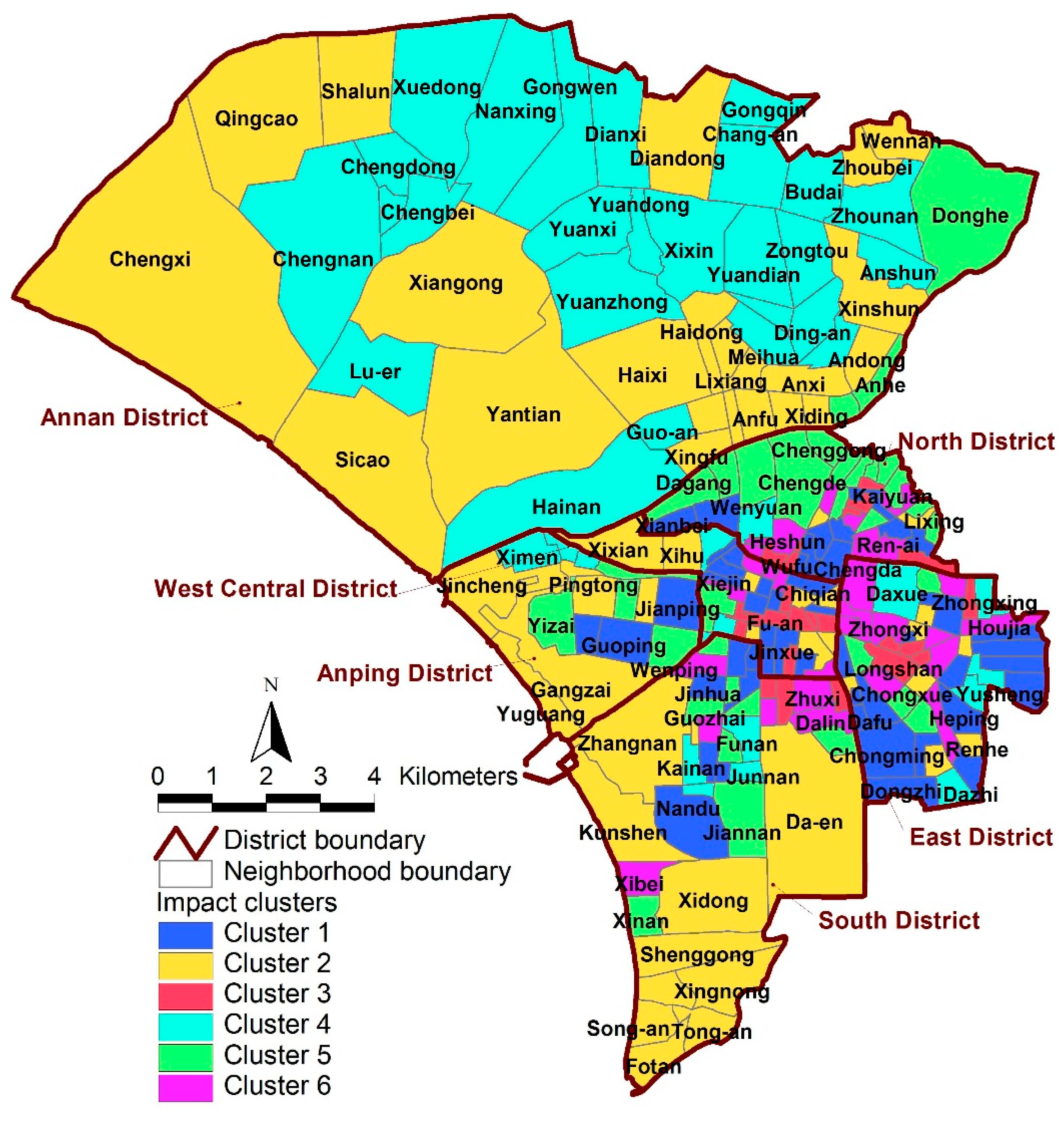
| Layers | Definition | Data Source/Resolution, Scale | Used Research Area Unit |
|---|---|---|---|
| Slope | The slope is derived from a digital elevation model (DEM), cell values are in percent slope gradient. Pixel value range: 0–100 | Generated from 20-m DEM of the Council of Agriculture/20 m | degree |
| Land Use | Land uses are assigned to five classes: urban development, agricultural land, forest, water, and other uses. | Land Use Investigation of Taiwan, 1993, 2008/1:5000 | - |
| Excluded | A map showing areas excluded from urbanization. | Urban growth plan of Tainan/20 m | - |
| Urban | Built-up land extent for the year. The model simply requires a binary urban/nonurban classification. Pixel value range: 0 = nonurban 0 < n < 256 = urban | 1985: Topographic map, 1985/1:25,000 | - |
| 1993: Land Use Investigation of Taiwan, 1993/1:5000 | - | ||
| 2008: Land Use Investigation of Taiwan, 2008/1:5000 | - | ||
| 2014: Taiwan Electronic Map, 2014/1:5000 | - | ||
| Transportation | Road network images. It should be binary (road/non-road). Binary: 0 = non-road, 0 < n < 256 = road | 1985: Topographic Map, 1985 | - |
| 1993: Land Use Investigation of Taiwan, 1993/1:5000 | - | ||
| 2008: Land Use Investigation of Taiwan, 2008/1:5000 | - | ||
| 2014: Taiwan Electronic Map, 2014/1:5000 | - | ||
| Hillshade | The hillshade is derived from a digital elevation model (DEM) and must be a grayscale image. | Generated from 20-m DEM from the Council of Agriculture/20 m | - |
| Surface temperature | Average surface temperature | 1. Land Use Investigation of Taiwan, 1993, 2008/1:5000 2. A predicted result for urban growth in 2030/20 m | °C |
| Surface runoff | Total volume of overland flow draining off the land | 1. Land Use Investigation of Taiwan, 1993, 2008/1:5000 2. A predicted result for urban growth in 2030/20 m | m3/s |
| Habitat diversity | Shannon–Weaver index | 1. Land Use Investigation of Taiwan, 1993, 2008/1:5000 2. A predicted result for urban growth in 2030/20 m | - |
| Indicators | Year(s) | Mean | Std. Dev. | Range | Min | Max |
|---|---|---|---|---|---|---|
| Surface temperature (°C) | 1993 | 34.017 | 0.473 | 1.618 | 32.692 | 34.310 |
| 2008 | 34.049 | 0.509 | 2.129 | 32.751 | 34.880 | |
| 2030 | 34.245 | 0.536 | 2.259 | 32.771 | 35.030 | |
| 1993–2008 | 0.032 | 0.308 | 1.603 | −0.834 | 0.769 | |
| 2008–2030 | 0.196 | 0.095 | 0.621 | 0.010 | 0.630 | |
| Surface runoff (m3/s) | 1993 | 0.187 | 0.037 | 0.145 | 0.111 | 0.256 |
| 2008 | 0.190 | 0.031 | 0.126 | 0.115 | 0.241 | |
| 2030 | 0.202 | 0.032 | 0.125 | 0.120 | 0.245 | |
| 1993–2008 | 0.003 | 0.018 | 0.101 | −0.045 | 0.056 | |
| 2008–2030 | 0.202 | 0.032 | 0.125 | 0.120 | 0.245 | |
| Habitat diversity | 1993 | 0.394 | 0.539 | 2.040 | 0.000 | 2.040 |
| 2008 | 0.375 | 0.366 | 1.516 | 0.000 | 1.516 | |
| 2030 | 0.280 | 0.337 | 1.260 | 0.000 | 1.260 | |
| 1993–2008 | 0.178 | 0.318 | 1.776 | −0.681 | 1.095 | |
| 2008–2030 | −0.096 | 0.319 | 1.960 | −1.267 | 0.693 |
© 2017 by the authors. Licensee MDPI, Basel, Switzerland. This article is an open access article distributed under the terms and conditions of the Creative Commons Attribution (CC BY) license (http://creativecommons.org/licenses/by/4.0/).
Share and Cite
Kuo, H.-F.; Tsou, K.-W. Modeling and Simulation of the Future Impacts of Urban Land Use Change on the Natural Environment by SLEUTH and Cluster Analysis. Sustainability 2018, 10, 72. https://doi.org/10.3390/su10010072
Kuo H-F, Tsou K-W. Modeling and Simulation of the Future Impacts of Urban Land Use Change on the Natural Environment by SLEUTH and Cluster Analysis. Sustainability. 2018; 10(1):72. https://doi.org/10.3390/su10010072
Chicago/Turabian StyleKuo, Hsing-Fu, and Ko-Wan Tsou. 2018. "Modeling and Simulation of the Future Impacts of Urban Land Use Change on the Natural Environment by SLEUTH and Cluster Analysis" Sustainability 10, no. 1: 72. https://doi.org/10.3390/su10010072



